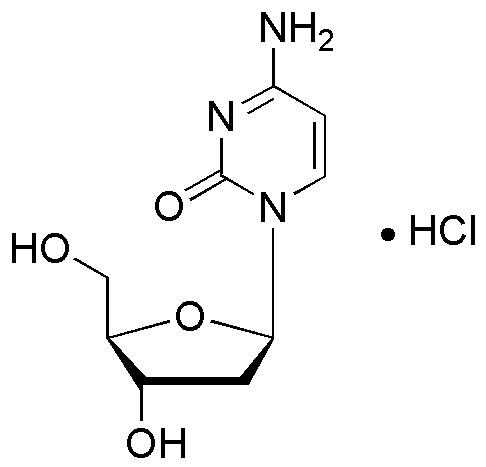2'-Deoxycytidine hydrochloride is widely utilized in research focused on:
- DNA Synthesis: This compound serves as a building block in the synthesis of DNA, making it essential for genetic research and biotechnology applications.
- Antiviral Research: It is used in studies aimed at developing antiviral therapies, particularly for viral infections like HIV, due to its role in nucleoside analogs.
- Cell Culture: Researchers incorporate it into cell culture media to support the growth of various cell lines, aiding in cancer research and drug development.
- Genetic Engineering: The compound is crucial in CRISPR and other gene-editing technologies, allowing scientists to manipulate genetic material effectively.
- Pharmaceutical Development: It is explored in the formulation of nucleoside-based drugs, providing therapeutic options for various diseases, including cancer.
General Information
Properties
Safety and Regulations
Applications
2'-Deoxycytidine hydrochloride is widely utilized in research focused on:
- DNA Synthesis: This compound serves as a building block in the synthesis of DNA, making it essential for genetic research and biotechnology applications.
- Antiviral Research: It is used in studies aimed at developing antiviral therapies, particularly for viral infections like HIV, due to its role in nucleoside analogs.
- Cell Culture: Researchers incorporate it into cell culture media to support the growth of various cell lines, aiding in cancer research and drug development.
- Genetic Engineering: The compound is crucial in CRISPR and other gene-editing technologies, allowing scientists to manipulate genetic material effectively.
- Pharmaceutical Development: It is explored in the formulation of nucleoside-based drugs, providing therapeutic options for various diseases, including cancer.
Documents
Safety Data Sheets (SDS)
The SDS provides comprehensive safety information on handling, storage, and disposal of the product.
Product Specification (PS)
The PS provides a comprehensive breakdown of the product’s properties, including chemical composition, physical state, purity, and storage requirements. It also details acceptable quality ranges and the product's intended applications.
Certificates of Analysis (COA)
Search for Certificates of Analysis (COA) by entering the products Lot Number. Lot and Batch Numbers can be found on a product’s label following the words ‘Lot’ or ‘Batch’.
*Catalog Number
*Lot Number
Certificates Of Origin (COO)
This COO confirms the country where the product was manufactured, and also details the materials and components used in it and whether it is derived from natural, synthetic, or other specific sources. This certificate may be required for customs, trade, and regulatory compliance.
*Catalog Number
*Lot Number
Safety Data Sheets (SDS)
The SDS provides comprehensive safety information on handling, storage, and disposal of the product.
DownloadProduct Specification (PS)
The PS provides a comprehensive breakdown of the product’s properties, including chemical composition, physical state, purity, and storage requirements. It also details acceptable quality ranges and the product's intended applications.
DownloadCertificates of Analysis (COA)
Search for Certificates of Analysis (COA) by entering the products Lot Number. Lot and Batch Numbers can be found on a product’s label following the words ‘Lot’ or ‘Batch’.
*Catalog Number
*Lot Number
Certificates Of Origin (COO)
This COO confirms the country where the product was manufactured, and also details the materials and components used in it and whether it is derived from natural, synthetic, or other specific sources. This certificate may be required for customs, trade, and regulatory compliance.


